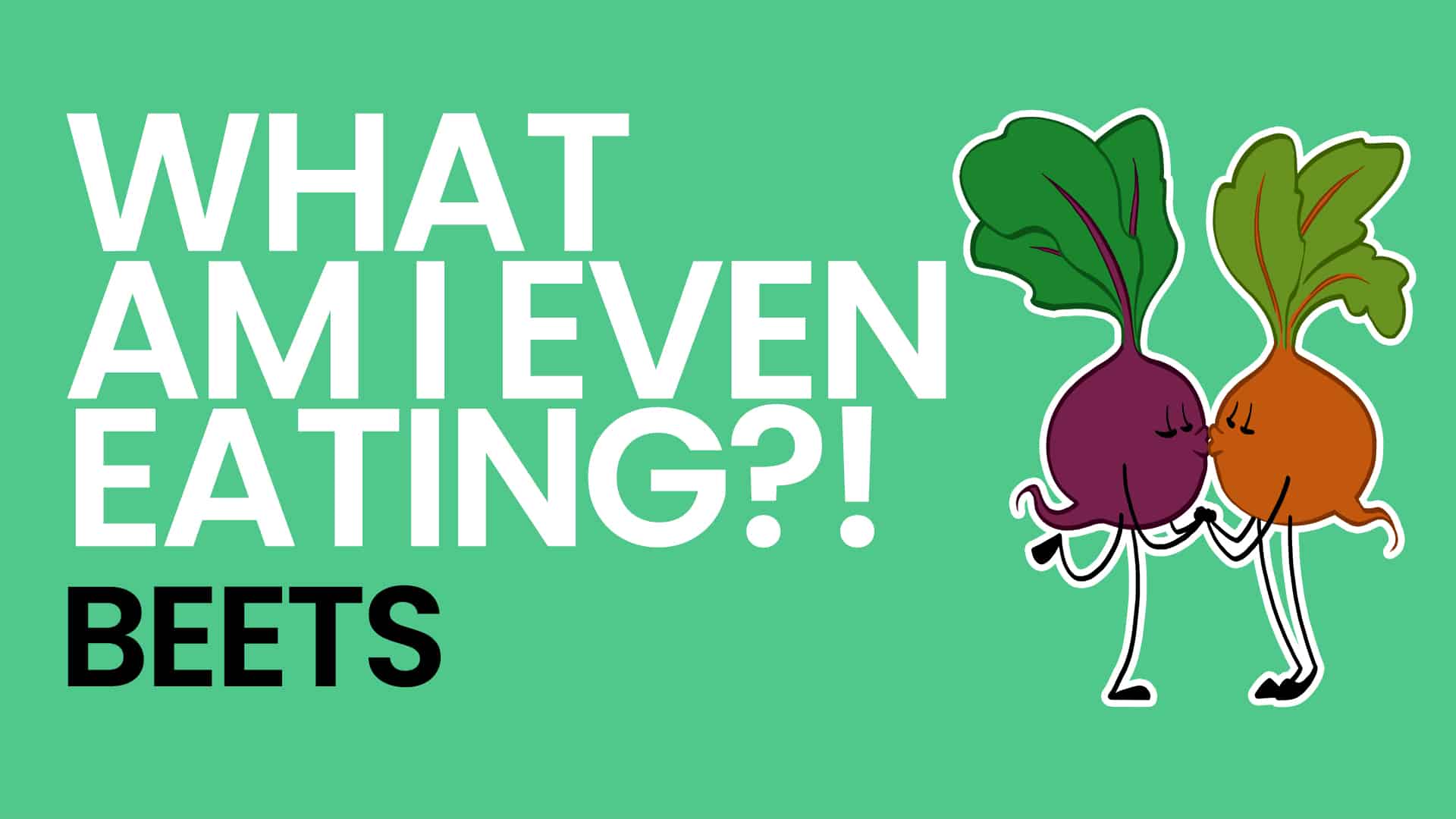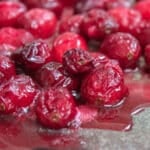Beets
A beet, in culinary terms, is the nutrient rich taproot of a leafy green plant native to the Mediterranean basin. Beets are grown as vegetables for their root and leaves but also serve as a source of sucrose for industrial sugar production.
Technicalities
A beet is a taproot. Taproots are a large, dominant root that forms centrally out of the base of certain plants. Other smaller roots branch out from the main taproot and it serves as a storage organ for the plant’s nutrition. Carrots, radishes, parsnips, turnips, and other vegetables are taproots.⁵
Name
In the North America, the word “beet” is preferred for describing both the crop and the prepared food. In the United Kingdom, “beetroot” is the preferred term.
Our word “beet” comes to us by way of Old English “bēte” which came from the ancient Latin “beta”. It is possible that “beta” originated from an older, Celtic word for the vegetable or that it was named for the Greek letter “B” (called beta) because the bulbous root resembles the curves of that Greek letter.
The ancient Greeks referred to beets as “teutlion”, which I believe means “squidlike” in Ancient Greek. They named it this because the leaves look like squid tentacles and the taproot looks like a squid’s head. ¹⁸
The scientific binomial “Beta vulgaris” is a combination of the ancient Latin name and the Latin word that means “common”. Effectively it means “the common beet”.
Characteristics
Sight
The iconic beet is a bulbous root with a purple skin and a rich red interior from which dark green glossy leaves sprout on reddish stalks. Beets also come in yellowish and white varieties.
Smell
Beets have an earthy, rich, vegetal smell raw. This aroma sweetens up after cooking as the sugar breaks down, giving off a syrupy earthy aroma.
A major aroma chemical in beets is Geosmin, which has a fresh earthy aroma. Geosmin is commonly recognized as the smell soil has after a strong rain. That is because it is produced in the soil by bacteria that is responsive to moisture. The human nose is very sensitive to Geosmin.⁸
Taste
Boiled or roasted beets have an interesting syrupy sweet/sour taste with strong earthy vegetal notes. As a taproot, you can taste the vegetable-like similarities with other taproots like turnips and carrots alongside beets’ unique taste.
Physical
Beets are dense vegetables with a thin but sturdy skin.
History
It all begins with the Sea Beet, Beta vulgaris subspecies maritima. The sea beet is the wild ancestor of our domesticated beet. It grows wild around the shores of the Mediterranean as it has since ancient times. Ancient Mediterraneans began cultivating this plant not for its root, but for its leafy greens. These greens, known as “chard”, were domesticated around 2000 BC to season the soups of Egyptians, Greeks, Romans, and other coast dwellers. ²’³’⁴
It wasn’t until around 200 AD that the beet’s root began to feature prominently in cuisine. Romans of this era took the older varieties of leafy beet and hybridized them with native European varieties to create plants with the large, bulbous taproots we recognize today. These late Roman-era beets came in both the red and white varieties.⁴ The red ones seem to have been bred simply because they were prettier.
The popularity of beets, including the red Roman one, spread in Europe during the Middle Ages where they thrived in that region’s cold, mucky soil. Beets are closely associated with Eastern European countries like Russia, Ukraine, Belarus, Poland, and the Jewish Diaspora from those places. Beyond slavic countries, beets also played parts in the cuisines of the baltics, scandinavians, balkans, and Germany. More differentiation occurred with animal feed and sugar production varieties being developed.
It was in Europe at this time that sugar from cane began to be popular. Cane sugar was expensive, occasionally hard to get, and also generally produced by slaves. Cane sugar meant for Europe in the medieval era was initially produced by Arabs in the Mediterran, then by Europeans on plantations in the Atlantic isles off Africa. European Abolitionists recognized beets as an alternative to cane sugar and began to promote them. In the early 1800s, white beets were bred to be sugarbeets and formal processing of beets into sugar began.¹⁶
From the very start of the settling of the Americas, colonists experimented with which Old World crops grew well in the New World. Among the many crops experimented with were different varieties of beets. The fertile and diverse soils of North America proved to be receptive to beets, particularly chard and table beets which were cited as being grown in US gardens by the 1800s.
Beets came to the US with colonists. By the 1800s there are mentions of chard and table beets being grown in US gardens.⁴ George Washington grew beets at Mount Vernon.¹⁷ Beet sugar production in the US was attempted in the 1830s-1850s unsuccessfully. It took off after the Civil War partly due to better practice and partly due to less competition from slave-grown cane sugar.
Sugar Timeline & Social Justice
4000 BC – Sugarcane domesticated in Taiwan & Papua New Guinea
1 AD – Crystalline sugar produced in India – Greeks & Romans gain knowledge of it as medicine
700s AD – Arabs begin to produce sugarcane on plantations around the Mediterranean, Caspian, & Fertile Crescent.
During the medieval era, sugar was produced from sugarcane around the mediterranean and middle east. Sugar production was labor intensive and hard on the soil, but very profitable to the people controlling the trade. Oftentimes, peasant labor was used to produce the sugar, which was unpleasant because they didn’t really share in the profits. Other times, particularly on medieval arab sugar plantations, slaves were used. These slaves were sourced from Africa, Europe, and Asia.
1440s – The portuguese set up sugar plantations on the Canaries, Madeira, and Cape Verde islands using black slaves. These are the progenitors of slave plantations in the Americas.
1540s – Portuguese begin sugar production in Brazil.
1625 – Dutch start sugar production in Caribbean
In the Americas, European servants and indigenous slaves were the initial workers on sugar plantations. As they died from disease or were phased out, black slaves took their place. AS production in the Americas expanded, sugar turned from a luxury for the rich to a commodity for the middle and lower classes. It was being produced so much and so cheaply that large sections of society had access to it during the 1700s. During this time, it became the most valuable import for countries like Britain.
1791 – British Abolitionist movement boycotted sugar to protest slavery
1794 – Revolutionary France abolishes slavery (only to reinstate it in 1804, then abolish it for good in 1815)
With mass access to things like sugar and cotton, civil society began to be concerned with how these products were produced. Religious social organizations were established which sought to abolish slavery by pressuring their governments. In Europe, these succeeded.
1747 – Sugar first isolated from beets in Germany
1800 – Sugar beet bred specifically in Germany
1801 – First sugar beet factory in what is now Poland (but was German at the time)
1840 – 5% of world’s sugar derived from Beets
1880 – 50% of world’s sugar derived from beets
As the viability of beet sugar grew, it’s moral advantage became more apparent. Sugar beets were grown by free labor, rather than slave labor. This gave beet sugar moral cache which abolitionists in the US who promoted it as an alternative to the cruelty of cane sugar. Slavery was officially abolished in the US in 1865, but cane sugar continues to be produced under difficult conditions even tantamount to slavery today.
Medicinal History
In Medieval Europe beets were recommended to treat digestion and blood issues.²
The ancient Romans associated beets with amorousness and desire. According to their legend, the red beets they developed were responsible for Aphrodite’s beauty. It was believed that a couple that ate from the same beet would fall in love. Beets were also featured in murals on the walls of Pompeii’s brothels, highlighting their sexual association.
Nutrition⁹
Potassium – Beets are actually rather high in Potassium. They have 305mg/100g while bananas have 358mg/100g.
Sugars – 8g sugar/100g. Makes them sweet and the beet energy rich.
Fiber – 2g fiber/100g. Good source of fiber.
Contains: Vitamins C, B-6, A, K, B-9 (Folate)
Nitrite – Beets contain high amounts of nitrites (11.4g/L in beetroot juice). Nitrites help with bloodflow and oxygen delivery. Athletes like to drink beetroot juice to replenish the strength in their muscles.¹⁰ Also, that enhanced bloodflow likely has a aphrodisiac effect.
Boron – Beets contain quantities of the element boron. Boron is helpful for the healthy development of the beet as it helps oxygen to be passed through cell walls in the plant. Farmers will add boron to the soil of their beet fields to improve plant health. Boron is also understood to play a part in the production of human sex hormones.¹¹
Antioxidants – Beets also have antioxidants like betalains, which also give the beet its color¹²
Eating Beets
One of the most basic and common ways to eat beets is simply roasting or boiling them. A sliced or quartered boil beet is a common vegetable side dish or addition to salads. Beets are also commonly pickled to preserve them and then eaten cold.
Beets are also commonly canned.
In ancient times beets were grown for their greens, known as chard. Today chard is still a common green. Known in the US as “Swiss Chard” it is a large glossy leaf with a bright red stalk. When cooked the bitterness is cut and it has a rich succulent flavor. Chard is rich in vitamins, minerals, and fiber. Swiss Chard isn’t necessarily Swiss, as it comes originally from Sicily.⁷ Swiss Chard also comes in a charming colorful variety called “Rainbow Chard”, which has an assortment of different colored stalks.
Betsy’s Beet Recipe
One large beet, remove greens and protruding roots. Place in an oven safe dish or pan stem down. Drizzle with olive oil. Roast in oven at 375 for 45 minutes. Remove, and skin will pull right off. Eat with olive oil or butter.
Global Cuisine
For many, the most iconic beet-related food is Borscht. Borscht is the Ukrainian name for a variety of sour soups traditionally popular in eastern europe. Borscht comes in many colors depending on what it’s made of (sorrel[green] rye[white] cabbage[pale orange]) but the most recognizable type is red with beets. It is a treasured, commonplace food among East Slavs, and has even made its way into space in tube form during the Soviet space program days.⁶
Culture
Dwight Shrute, from the Office, has a beet farm.
Beet Sugar
Sugar beets are specific varieties of beet cultivated purely to be processed into sugar. Around 20% of the world’s sugar comes from sugar beets.¹⁶
In 2021, the world produced 270 million tons of sugar beets.
200000 tons red beet produced in Wester Europe each year.
Beets for animal feed constitute 10 million tons.
Sugar beets have 15-20% sugar while table beets have around 10%
Other Applications
Beet “cakes” that are the spent biomass after they are pressed for sugar are used as animal feed.
Beets have also been used to make red food coloring or dyes.²
The reddish color of beets also made them a good source of rouge for make up.
Varieties of Beet
Beta Vulgaris is the species of plant from which all cultivated beets come. Broadly, it can be classified into the following categories
Sugar Beets: Pale beets grown specifically to be processed into sugar
Swiss Chard: Grown for the broad leafy tops as vegetables
Spinach Beets: Also grown for their leaves
Mangelwurtzel: Large pale beet grown for animal feed
Table Beets: the common red beets we think of, of which there are many sub varieties
Varieties of Table Beet
The red table beet is the iconic beet we generally think of. Within this subsection of beet there are plenty of different varieties. Within the following broad varieties there are even more types and breeds of beet, but these are the main kinds of table beet.
Fresh-Market: red & round, the most common
Chioggia: alternating red and white taproot
Golden: yellowish beetroot
White: very pale beetroot
Elongated: cylindrical, earthy flavored beet
Processing Beets – beets bred to be processed into sliced beets. Cylindrical shape rather than bulbous to make more uniform slices. Generally canned or otherwise preserved. Red.
Global Production
Global production of sugar beets hovers around 270 million tons each year.¹⁹
Russia 50 mil tons
France 38 mil ltons
Germany 30 mil tons
USA 26 mil tons
Turkey 18 mil tons
Poland 14 mil tons
China 12 mil tons
Egypt 11 mil tons
Ukraine 10 mil tons²⁰
The global beet market is worth about $5 Billion.
Growing Regions²¹
(the following refers to sugar beets, not table beets)
Sugar beets account for 55-60% of the US’s production of sugar.
Sugar beets are grown in the following states:²²
Minnesota – 11 mil tons
Idaho – 7 mi tons
North Dakota – 5.5 mil tons
Michigan – 4.3 mil tons
Nebraska – 1.4 mil tons
Montana – 1 mil tons
California – 1 mil tons (3.23% of US production, 0.37% of world production)
Wyoming – 900k tons
Colorado – 740k tons
Oregon – 380k tons
California’s Imperial Valley seems to be California’s major growing region.
California Beet History
Table beets may have been grown in California prior to this, but sugar beets have a history there which gets serious around 1867. A man named Ebenezer Dyer bought sugar beet seeds form germany and planted them in the Union City area (then called Alvarado). The crop grew well there so he opened a sugarbeet processing factory run by German immigrants in 1870. The factory closed in 1873 but sugar beet production had caught on in California by then and continues to this day. ²³
I was not able to find information on the first table beets in California. It could have been the Spanish but I think it’s more likely that anglo colonists introduced them.
Soil
Beets prefer sandy loam, silt loam, or muck soil. Denser soils can also support beets but the thickness may impair harvesting and root growth. Uniform soil moisture is important to prevent rot diseases, as is crop rotation. A soil pH of 6 is preferred for higher yields. It’s important to test for residues before planting beets.¹³-¹⁴ Crop rotation is important for adding nutrients back into the soil and preventing pests from building up.
Water
Beets require a delicate balance of water to grow properly. Overwatering can cause rot, stopped growth, or “damping off” (a condition where the young plant collapses). During the early growing period, more frequent and lighter watering is preferred to keep the topsoil moist to allow for the sprout to break the surface. As the weather gets hotter, heavier waterings are better to ensure the soil doesn’t dry out. Frequent irrigation would be twice a week, standard irrigation would be once a week. Beets may need between 12-14 inches of water per acre per season.¹⁴ That would be equivalent to around one acre-foot per season, or 350000 gallons per acre.
Temperature & Sun¹⁴
Beets are a cool season crop. They grow best between 50 & 64F. Higher temperatures can lead to uneven growth and unappealing taproots.
Growing Season¹⁴
An annual plant completes its lifecycle in one year. A biennial completes it it two. Beets, if left to complete their lifecycle would germinate and grow during their first year, then flower and seed during their second. In nature, that’d make them a biennial. In farming, beets are not left to go to seed as they are harvested during the first year of their life. That makes them an annual crop.
If left to their own devices, a beet would spend it’s life the following way. In spring of its first year, it would sprout and grow leaves and a small taproot. The leaves would grow larger, gathering energy and storing it in it’s taproot. It would do this all summer and fall until the winter froze off its leaves, leaving the frost-resistant taproot to sit underground overwinter. Then in spring of the second year, the leaves would return and a flowers would grow. The pollination process would commence, seeds would be fertilized and then dropped for next year. This process would use up the energy stored in the beet’s taproot, and then the mother plant would die, leaving a great deal of seeds to grow anew.
Humans interrupt this natural process. Instead of all the taproot nutrients going into the beet’s own flowers & seeds, we choose to eat the taproot. The ideal time to do that is when it’s grown to its greatest extent towards the end of the first year, and before it begins to convert its energy into seeds. We make beets an annual crop, while in nature they’d be a biennial plant.
Table beets produce a crop each year. Depending on type, beets need a 42-80 day growing season.
Table Beets: 42-56 days
Round Beets: 60-70 days
Cyllindrical Beets (processing): 70-80 days
Planting¹⁴
Planting is done in March or April. Propagated seeds should be a half inch to an inch deep. It takes 8-10 pounds of seeds to plant an acre of beets.¹⁴
Beets extract a lot of nitrogen from the soil so they are often grown in rotations with nitrogen fixing crops like legumes.
In order to have extended availability of beets during harvest time, planting can be staggered by a few weeks. Different rows can be planted at different times so the beets don’t need to be harvested and stored all at once.
Maturation¹⁴
Seeds germinate 5-15 days after seeding. The first half of the beet’s growing cycle is characterized by the leaves shooting up. Once those are set, they gather nutrients that fill out the taproot. The taproot gains most of its size in the second half of the growing process.
Fertilization¹⁴
Fertilization depends on soil quality.
Nitrogen: 150-200lb nitrogen/acre, lower if beets follow legumes in a crop rotation, higher if they follow grains. Apply before planting or during first phase of growth. N helps make healthy greens.
Phosphorous: 50-70lb of phosphate is needed per acre, ideally 1 inch beneath the seed to prevent seedling burn. Phosphorous helps early seedling growth and prevents damping off.
Potassium: 60-150lb of K is needed per acre depending on soil quality. Should come in the form of potash.
Sulfur: can be added as sulfates during planting (15-20lb/acre) or as elemental (30-40 lb/acre fine grain) the preceding year.
Magnesium: add if needed in small quantities (10-15lb/acre). Add with lime prior to seeding.
Boron: Boron is a very important mineral for beets as it helps prevent canker disease. Fields need between 3-10 lb/acre depending on if canker is precent in past harvests.
Lime: Beets like low pH soil so lime can be applied to maintain the ~6pH. Lime should be added as needed, ideally weeks prior to planting.
Field Maintenance
Weeding is important. It must be done to ensure beets are getting all the available nutrients. In general, beets are a relatively low maintenance crop and don’t necessarily need tons of attention.
Harvesting¹⁴’¹⁵
In california beets are harvested from mid July to the end of October. Beets will vary in size at harvest time so they are divided up into “Grades”.
Grade 1: 1-1 ⅝ inch diameter
Grade 2: 1 ⅝ – 2 ⅝ inch diameter
Grade 3: 2 ⅝ – 4 inch diameter
Ideally, harvest will occur when there is 25% Grade 1, 60% Grade 2, and 15% Grade 3. This varies by type of beet. Once the preferred ratio is set harvesting can begin.
First the beets need to be “Topped”. Here meaning their upper leafy part is removed with a blade or a flail. This leaves the naked beets sticking out of the ground with no greenery, ready to be collected. I believe the topped leaves are left to refertilize the soil, but I am not certain.
Then a “lifter” comes along to dig the beets up out of the ground. The lifter also does more topping, removing more greenery and leaving the beets as just the taproot. A flailed belt then removes more dirt and the beets are transferred to a truck waiting alongside to carry them away.
Yields can be anywhere from 18-25 tons per acre.¹³
Harvesting can also be done by hand, by simply picking the beets from the ground by their greens. The beets are then washed, bunched, and packed. Greens are left on.
Storage¹⁴
Beets should be dry and soil-free before storage. They should have their tops removed and any rejects should be discarded to avoid spreading rot to healthy beets. Beets should be stored at 32F and high humidity to prevent drying, evaporation, and wilting. Beets will keep 4-6 months under these storage conditions.
Processing¹⁴
Beets for the grocery store are bunched by hand and shipped in crates. Processing beets can be shipped in bulk to the processing facility.
Threats
Weeds, aphids, insects, worms, spots, mildew, root rot.
Sustainability
Beets are naturally sustainable. They don’t take much water, grow quickly, are nutritious, and really don’t wipe out the soil much.
Organic Beets
Organic beets are grown commonly. The major difference is that these varieties are non-GMO and use organic fertilizers.
Sources
1 – Medium Beets
4 – University of Nebraska Cropwatch, History of Sugarbeets
10 – Beetroot Juice Paper
11 – West Coast Seeds Beets Article
12 – Potential Benefits of Red Beetroot
13 – Oregon State Beets
14 – UC Beet & Chard Production California
15 – Sugar Beet Farming
19 – Statista global beet production
20 – FAO global beet production data
21 – USDA Sugarbeets production






